
|
Nov 07, 2008
Hard Lesson about Solar Realities for NOAA / NASA
By Warwick Hughes with input from David Archibald
The real world sunspot data remaining quiet month after month are mocking the curved red predictions of NOAA and about to slide underneath. Time for a rethink I reckon NOAA !! Here is my clearer chart showing the misfit between NOAA /NASA prediction and real-world data. Regular readers might remember that we started posting articles drawing attention to contrasting predictions for Solar Cycle 24, way back on 16 December 2006. Then in March 2007 I posted David Archibald’s pdf article, ”The Past and Future of Climate”. I would like to see another version of David’s Fig 12 showing where we are now in the transition from Cycle 23 to Cycle 24. Solar Cycle 24 Prediction Issued April 2007 from NOAA /NASA.

See larger image here
David provided several new graphics. The first compares Solar Cycle 23 to the minima of the late 20th century and the late 19th and early 20th century. Note the similarity to the older cycles in the current cycle.

See larger image here
David has a bit of fun with this graphic which is aligned on the previous solar minimum. Solar Cycles 3 and 4 prior to the Dalton Minimum had very similar shapes and amplitudes to Solar Cycles 22 and 23.
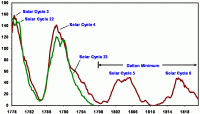
See larger image here
See the full post and all the graphics here.
Nov 06, 2008
Winter’s Chill Comes Early as Fairbanks Records Fourth-Coldest October, High Plains Hit by Blizzard
By Tim Mowry, Newsminer
FAIRBANKS - One of the coldest Octobers on record in the Interior has the Yukon River grinding to a halt and residents settling in for winter. October 2008 went down as Fairbanks’ fourth-coldest October on record since 1904, according to meteorologist Rick Thoman with the National Weather Service in Fairbanks. The average temperature of 15.1 degrees was 8.4 degrees below normal.
The coldest October on record in Fairbanks was in 1996, which had an average temperature of 13.1 degrees. “That year we had three days in a row with lows in the mid 20s below,” Thoman recalled. “We didn’t have anything quite like that this year. “It was just persistently below-normal temperatures rather than some great cold outbreak,” he said. “There were no records set.” The low temperature for the month at Fairbanks International Airport, the weather service’s official measuring station in Fairbanks, was 13 below - recorded on Oct. 29 and well shy of October’s record low: 28 below, set on Oct. 27, 1935.
There were 13 days when the low temperature was zero or colder, the most sub-zero days in October since 1965, which holds the record of 14 sub-zero days in October and ranks as the second-coldest October on record. “The number of days below zero was notable,” Thoman said. Only two days during the month saw temperatures above normal, the result of a chinook that blew into the Interior from the Gulf of Alaska on Oct. 10-11 and pushed temperatures into the high 40s before dropping again. Had it not been for the chinook, this October likely would have made the top three coldest Octobers on record, Thoman said. The warm blast of air also prevented Fairbanks from having one of its earliest snowpacks on record by melting about 4 inches of snow that had fallen the week before, Thoman said. As it was, the snowpack was established on Oct. 13. Total snowfall for the month was 12.2 inches, which is just slightly above normal.
The colder weather froze Interior lakes quicker and deeper than usual, but rivers are still in the process of freezing solid, said Larry Rundquist at the National River Forecast Center in Anchorage. The ice on the Yukon River has stopped moving in several Interior villages, including Circle, Galena, Tanana and Nulato, Rundquist reported. The ice on the Tanana River at Manley stopped running on Oct. 23, he said. The early part of winter has been much colder this year than normal in terms of “freezing degree days,” which Rundquist said are the driver for freeze-up and ice thickness. Freezing degree days are accumulated when the average daily temperature drops below 32 degrees. One freezing degree day is the equivalent of one degree below freezing. For example, if the average daily temperature is 22 degrees, it equals 10 freezing degree days. Fairbanks accumulated 600 freezing degree days in October this year, compared to an average of 260, Rundquist said.
In the Interior village of Eagle, on the Yukon River near the Canadian border, the coldest temperature in October was 24 below, said resident John Borg, who reports temperatures to the National Weather Service. The Yukon River ice hasn’t frozen completely yet, but it won’t be long, Borg said. “The ice isn’t packed in shoulder to shoulder yet,” he said by phone on Monday. “It’s got a ways to go yet. I’d say a minimum of two weeks unless we get some severe cold weather.” Most of the 150 or so residents in the town at the end of the 160-mile Taylor Highway have settled in for the winter, he said. The road, which isn’t maintained in the winter, is pretty much impassable at this point, he said. “Most everybody planning to be here for the winter is on this side of the summit,” he said, referring to 3,650-foot American Summit. See story here. Contact staff writer Tim Mowry at 459-7587.
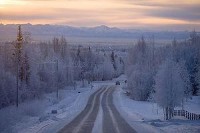
Also in the lower 48 states, the USAToday reported the season’s first major blizzard pounded the Dakotas and parts of Wyoming and Nebraska Thursday with wind gusts approaching 80 mph. Schools were shut down, highways closed and power was knocked out across the region. Wind gusts of 78 mph were reported in Rapid City, S.D., and 38.5 inches of snow had fallen on nearby Deadwood, S.D., according to a blizzard warning issued by the National Weather Service. In Wyoming, Chester Hejde, 78, said the storm is close to the worst he’s seen in his lifetime. “A neighbor drove over here and he says he didn’t know where he was, and he’s lived here all his life,” said Hejde, who operates the Bunkhouse Bed and Breakfast about 20 miles northeast of Sundance, Wyo. “We’re just socked in here.”
Nov 03, 2008
Sea Level at Kakadu
By John McLean
Kakadu National Park is regarded as one of Australia’s iconic parks because of its flora, fauna, landforms and history. It is often claimed that this park is under threat from rising sea level so this discussion looks at what is known about sea level in the region. The park has about 100km of coastline fronting Van Diemen Gulf, which is basically a large bay with narrow entrances to the north (Dundas Strait) and the west (Clarence Strait). The East Alligator River and the South Alligator River, along with the smaller West Alligator River and Wildman River drain fresh water from the park into the Gulf.
It is claimed that the natural levees near the mouths of these rivers are as little as 20cm above water level and could easily be breached by rising sea level, which would cause salt water intrusion into fresh water systems.
What was found: Sea level at Darwin and Milner Bay has a regular cycle of higher sea in summer (Dec-Feb) and lower sea in winter (June-August).
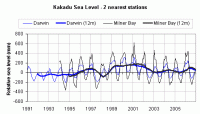
See larger image here
For these two locations sea level varies synchronously and in accordance with the state of the ENSO system, rising as the SOI moves in a positive direction (i.e. towards La Nina) and falling as the SOI moves in a negative direction (towards El Nino). It therefore follows that sea level at previous times of strong La Nina conditions might have topped the natural levees of the freshwater rivers especially if the La Nina conditions existed across the summer period of high seas. These two conditions were met across 1975-6 with the month average SOI values of 19.5, 11.8 and 12.9 from December 1975 to February 1976, so the levees may have been breached on that occasion. In the archive of SOI values we find 13 other December-February periods of positive SOI values and similar breaches may have occurred at that time.
It is also noted that sea level at Darwin since 1998 is lower than the general relationship with the SOI suggests. (If the line for SOI is raised to match the line for sea level in the pre-1997 period then after 1997 the line for SOI will be above the line for sea level.) The reasons for this are not clear but it does suggest that sea level is rising less than might be expected. The 12-month running average of sea level at Darwin matches that at Milner Bay quite well so it seems unlikely that there was a sudden change in the height of the tidal guage.
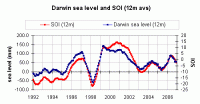
See larger image here
Read full analysis here.
Nov 02, 2008
Anti-Energy Collaborative Effort in Colorado
Paul Chesser, Climate Strategies Watch
Over at my Web site I’ve posted a long, blow-by-blow account of how Colorado Gov. Bill Ritter and his administration repeatedly enlisted the William and Flora Hewlett Foundation to pay for his global warming alarmist agenda (a “new energy economy") and for his efforts to keep the federal Bureau of Land Management from leasing for oil and gas exploration on the Roan Plateau. It’s sometimes a dry recitation but there are a ton of documents linked that I obtained from the governor’s office and from CDNR.
The quick-’n-dirty summary: Almost immediately after he took office Ritter had a “Climate Action Plan” he wanted to pursue, which included two new positions in his administration: a cabinet-level climate policy adviser to create “a bold and visionary climate action policy,” and a liaison to the Public Utilities Commission to “develop a climate-wise utility policy.” He asked for, and got, two annual grants from Hewlett for $200,000 ($400,000 total) to fund the positions. Ritter worked through Hewlett’s environmental program director Hal Harvey—a far-left, Obama-supporting (and -contributing) environmental extremist who founded the Energy Foundation and is president of the crackpot enviro/population control-advocating New-Land Foundation—to pay for his climate people. I guess the state budget process would not come up with the money fast enough for Ritter.
Within a few months Ritter had another environmental cause to fight: obstructing and delaying the Bureau of Land Management from leasing the rights to oil and natural gas exploration on the rich Roan Plateau. It had been ten years already since BLM was given the mandate to lease the Naval Oil and Shale Reserves, and it was finally ready to start doing so after years of environmental study and review. But that still wasn’t long enough for Ritter, his eco-cronies, Reps. Mark Udall and John Salazar, and Sen. Ken Salazar (pictured). All got involved in trying to further delay BLM.

Part of the strategy was for Ritter’s administration to make the case for much slower “phased leasing”
of acreage on the Roan, as opposed to the BLM’s somewhat quicker but still limited and methodical approach. The governor’s Department of Natural Resources sought out (and found) a cheap economist who would be willing to put together a vague case that showed phased leasing was a better idea that would reap better revenues for the state. And can you guess who they asked to pay for said cheap economist? Yep—the Hewlett Foundation, with Hal Harvey more than happy to help out. In fact, Harvey wanted to help so much that he gave campaign contributions to both Salazars and Udall as well.
The congressmen worked at the federal level to implement Ritter’s phased leasing goals, with Sen. Salazar’s legal counsel begging for the suspect economic analysis to buttress his case. But the congressmen’s and Ritter’s efforts fell short of their goals, as BLM moved forward with the leasing, which netted nearly $114 million for both the federal and state governments—“the highest grossing onshore oil and natural gas lease sale in BLM history in the lower 48 states.”
Nevertheless, it’s a sorry tale of how environmental extremists will fight together to the death for measures that would cripple our access to our own sources of affordable energy.
Nov 01, 2008
“Global Warming” Has Stopped
Lord Christopher Monckton
In a blog post, Bill Chameides says “global warming” is still happening. It isn’t. As the global temperature graph below shows, all four of the world’s major global surface temperature datasets (NASA GISS; RSS; UAH; and Hadley/University of East Anglia) show a decline in temperatures that have now persisted for seven years.
‘Global warming’? What ‘global warming’? All four of the world’s major surface temperature datasets show seven years of global cooling. The straight lines are the regression lines showing the trend over past seven years. It is decisively downward. Chameides’ graph overleaf appears to have been tampered with to exclude the very rapid cooling that occurred between 2007 (the curve stops in January 2007, when a strong El Nino artificially but temporarily boosted temperatures) and 2008. The fall in temperatures between January 2007 and January 2008, carefully not shown on Chameides’ graph, was the greatest January-January fall since records began in 1880.
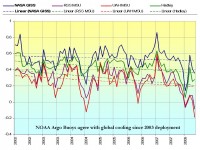
See larger image here
The UAH graph provides a complete answer to the Chameides’ attempt to suggest that skeptics” are confusing short-term and longer-term temperature changes. The year 2008 will turn out to have been no warmer than 1980 – 28 years ago. This is not a short-run change: the cooling trend set in as far back as late 2001, seven full years ago, and there has been no net warming since 1995 on any measure. Next, Chameides attempts to suggest that the recent cooling is caused by solar activity. He could well be right - however, if so, by the same token the warming that stopped in 1998 could also have been caused by solar activity - there was, after all, a solar Grand Maximum in the last 70 years of the 20th century, during which the sun was more active and for longer than at almost any previous similar period in the whole of the past 11,400 years.
Scafetta and West (2008) attribute more than two-thirds of the warming of the past 50 years to solar activity - the latest in a series of papers in all parts of the scientific literature that explicitly question the exaggerated estimates of climate sensitivity`perpetrated by the IPCC. Chameides’ final, desperate point is that the “green diamonds” he has so carefully selected from the 5-year running-mean graph that he has equally carefully blotted out show continuously-rising temperatures that overlay what he calls the short-term cooling.
Not so. As the first graph above shows, the linear regression not just for the past five years but for the past seven years shows a decisive and continuing cooling. Keenlyside et al. (2008) do not expect a new record year for global temperature to occur until at least 2015. If they are right, then the IPCC’s climate-sensitivity estimates must be - as Monckton (2008) finds them to be - prodigious exaggerations. False data will no longer convince any impartial mind to believe in the fantasy of anthropogenic “global warming”?
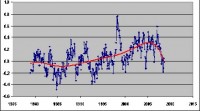
See larger image here
|
|
|
|











